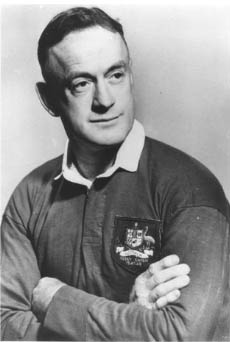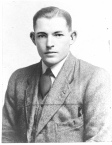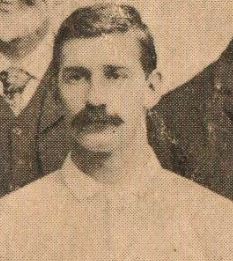
The Australia men's national rugby union team, nicknamed the Wallabies, is the representative men's national team in the sport of rugby union for the nation of Australia. The team first played at Sydney in 1899, winning their first test match against the touring British Isles team.

Cyril Towers was an Australian rugby union player, a state and national representative centre who made 57 appearances for the Wallabies, played in 19 Test matches and captained the national team on three occasions in 1937.
John Edward Thornett, MBE was an Australian rugby union player, who played 37 Tests for Australia between 1955 and 1967 and made an additional 77 representative match appearances. He captained Australia in 16 Test matches and on an additional 47 tour matches on the eight international rugby tours he made with Wallaby squads.
John Brass is an Australian former rugby union and rugby league footballer – a dual-code international. He made twelve international representative rugby union appearances with the Wallabies from 1966 to 1968 and six representative rugby league appearances for the Kangaroos in 1970 and 1975, as national captain on one occasion.

Arthur James Summons was an Australian representative rugby union and rugby league player, a dual-code rugby international fly-half or five-eighth. He captained the Australian national rugby league team in five undefeated test matches from 1962 until 1964 and later also coached the side.
Trevor Allan was an Australian dual-code rugby international who captained Australia in rugby union before switching to rugby league with English club Leigh.
Alan Stewart Cameron was an Australian rugby union footballer of the 1950s and 60s. A State and national representative lock-forward he made twenty Test appearances and over fifty additional tour match appearances for the Wallabies, captaining the national side in four Tests matches.

Arthur Cooper "Johnnie" Wallace was an Australian rugby union player, a state and national representative three-quarter who captained the Waratahs on 25 occasions in the 1920s as well as representing Scotland early in his career.

Tom Lawton Snr was an Australian rugby union player, a state and national representative five-eighth who made 44 appearances for the Wallabies, played in 14 Test matches and captained the national side on ten occasions.
Charlie Fox was an Australian rugby union player, a state and national representative second-rower who made 36 appearances for the Wallabies, playing in 17 Test matches and captained the national side on seven occasions in 1925.
Colin "Col" Windon, was a rugby union player and soldier who captained Australia – the Wallabies – in two Test matches in 1951. By age 18 Windon was playing at flanker for his club Randwick in Sydney's Shute Shield. After serving with the Second Australian Imperial Force in the Pacific Theatre during the Second World War, Windon resumed his rugby career in 1946. He was first selected for Australia for their tour of New Zealand that year. Despite the Wallabies losing both their Tests on tour, Windon impressed with his play.

Denis Lawson "Dave" Cowper was an Australian national representative rugby union player who captained the Wallabies for six matches including three Tests in 1933. He was the first Victorian player to captain his country in rugby union.
Between October 1966 and March 1967 the Australia national rugby union team – the Wallabies – conducted a world tour on which they played five Tests and thirty-one minor tour matches. Under the captaincy of John Thornett they toured UK, Ireland, France and Canada winning nineteen matches, losing fourteen and drawing three. At one stage they failed to win in four successive matches although in the Test match against England they gave the home side its heaviest defeat in 16 years. The tour marked the climax of the successful "Thornett Era" of Australian Rugby, buoyed by the leadership skills of skipper John Thornett and the outstanding abilities of greats of the game like Ken Catchpole, Peter Johnson and Rob Heming. Dick Marks and Peter Crittle also toured and would later become among the most influential administrators of Australian rugby.

Stan Wickham was a pioneer Australian rugby union player, a state and national representative centre who captained the Australian national side on a number of occasions in the early 1900s. He was tour captain for the inaugural Wallaby overseas tour, that to New Zealand in 1905.
Darby Briton Loudon was a New Zealand born rugby union player, a flanker who made sixteen representative appearances for the New South Wales state team in the 1920s. Four of these matches have since been decreed as Test matches by the Australian Rugby Union and Loudon, who led the side in one such match in 1922, was therefore a captain of the Australian national team.
John Noel Brian Hipwell was an Australian national representative rugby union player who played and captained the Wallabies. He played the majority of his career at scrum half and his representative career spanned 14 seasons from 1968 to 1981.
Robert Briton Loudon was a New Zealand born rugby union player, a flanker who made twenty-three representative appearances for the New South Wales state team in the 1920s. Seven of these matches have since been decreed as Test matches by the Australian Rugby Union and Loudon, who led the side in one such match in 1928, was therefore a captain of the Australian national team. After rugby union restarted in Queensland in 1929, and national selections were made from the two states Loudon played in six further full Australian Wallaby Test sides. In addition to his thirteen Test matches he made a further twenty-one tour match appearances for representative Australian sides on three international tours between 1923 and 1933.
Gregory Victor Davis was a New Zealand born, national representative rugby union player for Australia. He played at flanker and made seven international tours with Wallaby squads. He was the Australian national captain in 47 matches from 1969 to 1972 and led the Wallaby side on three overseas tours.

Peter George Johnson was an Australian international rugby union player. He enjoyed a long state and international career throughout the 1960s and made 92 national appearances for his country. He captained the Australian side in five Test matches.
Geoffrey Arnold Shaw is an Australian former national representative rugby union player who played for and captained the Wallabies. He made state representative appearances for both New South Wales and Queensland over an eleven-year period from 1969.







